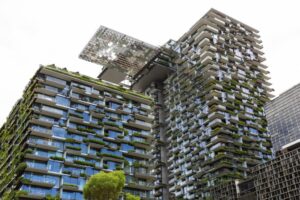Underserved Areas Are Grabbing Retail Investors’ Attention. Here’s Why.
In recent years, an increasing number of retail investors and developers have been shifting their attention toward undeserved communities. The Sun Belt for example, known for its high in-migration rates and friendly business environment, has been particularly attractive.
To capitalize on this trend, NewMark Merrill Cos. recently launched NewMark Merrill Hadler Community Partners, a venture that focuses on the acquisition, development, management and operation of retail centers in underinvested and undersupplied communities.
Commercial Property Executive asked Managing Director Jermaine McMihelk to discuss the unique challenges and opportunities presented by retail centers in these areas, particularly as balancing affordability, tenant demand and profitability have become central to the future of retail. Integra Realty Resources CEO Anthony Graziano also joined the conversation.
READ ALSO: Shopping Changed Dramatically. Retail Design Is One Step Ahead
Has NewMark Merrill Hadler Community Partners made its first investments yet? What specific U.S. areas are you targeting?
McMihelk: Quite simply, our mission is to be the best operator and investor in retail shopping centers in underinvested and undersupplied communities. That includes having the best tenant mix that is tailor made to every community that we serve and truly meeting their needs, authentic and genuine community connections and relationships that go beyond our shopping centers and allows us to contribute our time and resources to help solve broader issues and having a team that reflects and is passionate about the communities that we serve.
We have a few centers in the pipeline that we hope to announce soon which are within Los Angeles County, but our vision is to scale the platform nationally given the number of communities throughout the country that are underinvested and undersupplied.
How exactly do financial models differ when investing in this type of markets compared to more established retail areas?
McMihelk: A lot of our deals are value add with some opportunistic sprinkled in there, but I wouldn’t say that our models differ significantly from other markets. Like with a lot of repositionings, it’s important to be disciplined in modeling achievable and sustainable rent growth for both us and our merchants, and allowing worst-case scenario to be your base in regard to expenses. If you can make a deal pencil leading with those assumptions, it’s likely worth the risks.
Are there specific tax incentives, grants or government programs that make these investments more attractive?
McMihelk: Some areas that we operate in may qualify as Opportunity Zones and be eligible for specific tax incentives and grants, but we see that as sprinkles on the cake, and our initial focus is usually more so on quality real estate in great locations as opposed to designated zones or programs. We are typically long-term holders so we want assets that we believe will stand the test of time even without the presence of additional incentives, though we do leverage them when it is aligned with our business plan.
We see the market as a domestic emerging market with continued growth, density, solvable problems and the potential for outsized returns. This is truly what makes the market most attractive to us.
The commercial real estate industry has been quite enthusiastic about the recent Fed interest rate cut. To what extent will this move impact deal flow in retail? Is it too early to tell?
McMihelk: I think broadly that this recent rate cut will not have a significant impact on property values and deal flow in the short term, but it has injected a good dose of optimism into our space which is also important. I believe that if fundamentals remain sound with low vacancies, rising rents and manageable costs, we will likely begin to see an increase in property values and investment activity in mid to late 2025, assuming additional cuts this year and next.
Graziano: We think the rate cuts will assist deal flow, but the main driver will be occupier and rent driven. The NNN leased market may see a pop on the rate cut, but general retail won’t be affected that much. The bigger positive impact on the rate cut is the psychological boost to consumers, which may help drive retail sales.
Speaking of consumers, what are your strategies for balancing affordability for local consumers with the need for sustainable profitability?
McMihelk: This is a sensitive issue and one we feel uniquely qualified and positioned to address. For us, we must strike the right balance of meeting the consumer where they currently are, where the market is headed, all the while creating an environment that encourages sustainable investment and inclusive growth. Some of the ways we achieve this is through a great mix of small businesses and national tenants, being genuinely and authentically connected to the communities that we serve, and continuously figuring out ways to lend our time and contribute resources to playing a role in solving community issues outside the scope of our retail spaces.
READ ALSO: CRE Prices Are Stabilizing
Tell us more about how you select the right mix of tenants for neighborhood shopping centers in underserved areas.
McMihelk: Understanding the market at a few levels is important. Conducting a good void analysis will tell you what is missing, but what it doesn’t always accurately convey is what is truly needed. So, we layer on processes to make sure that we aren’t missing the highest return on investment, which is usually fulfilling a need.
A soft goods tenant could be a great fit for the center and be projected to do well, but a quality community-focused physician within walking distance in a community with low car ownership fills a true need and likely gets you a tenant in the space for decades with sustainable growth. Identifying these needs consistently comes from a true community connection and a nuisance understanding of the communities that you serve. That has everything to do with the makeup and capability of our team, along with having quality relationships within the community that allows us to consistently optimally serve them.
How do you mitigate high vacancy rates and tenant turnover in markets that are part of underserved areas?
McMihelk: I think it’s very important for owners to look at partnering with companies that are full-service, meaning management, leasing, marketing construction etc. all under one roof. It truly takes a village to consistently succeed in markets where others have found success and consistent returns to be elusive.
When you have a team that is completely aligned, and you have authentic and genuine relationships with the community, local leadership, tenants, law enforcement etc., you are then poised to navigate and solve the issues that underserved markets present. Without this kind of alignment, problem solving is extremely difficult to do and almost impossible across multiple projects.
What are some common challenges that arise when developing or revitalizing shopping centers in low-income or underserved neighborhoods?
McMihelk: One of the issues is that many of the centers tend to be older and sometimes not well maintained throughout the years, so it becomes extremely important to understand all physical aspects of the asset and accurately account for capital investments that will be needed on the journey to stabilization. You must also truly be connected to the community and area to understand what is needed and at the same time be able to simultaneously have conversations with merchants to better understand their current outlook…
Additionally, with the right business plan and turnaround story, you can partner with brands who are aligned with your vision and sometimes persuade those who may have been on the fence about a center.
In all, if you don’t approach the market diligently, with allies and with potential partners in hand, developing and revitalizing shopping centers in low-income neighborhoods can be difficult. A lot of the heavy lifting must be done on the front end.
How do you see the rise of e-commerce affecting neighborhood shopping centers in underinvested communities?
McMihelk: E-commerce has certainly impacted the retail business, but I would say that we have seen it to be more positive on shopping centers overall. As an example, a mom-and-pop restaurant in one of our centers can now reach even more customers. We see this being the case in a number of instances. Retail in general throws off more data than any other product type in commercial real estate: sales, foot traffic, yelp reviews etc. We tend to focus on how we can arm our customers with the best and richest market data, so that they can capitalize on this extended reach and continue to drive growth in their business alongside technology.
As we slowly move into 2025, how do you expect neighborhood shopping centers in undersupplied communities to perform?
Graziano: Retail has been broadly healthy in many sectors. Neighborhood shopping centers in undersupplied communities, due to land constraints or limited development options, will remain strong. Site selection and new development of neighborhood centers is supply and demand driven, and neighborhood retail remains strong in most markets.
Identifying markets where there has been retail redevelopment—think shopping center sites that converted to multifamily, or older shopping centers with terminal vacancy converted to medical office—leads to retail gaps since existing retail is removed from the market. The continued evolution of malls and eatery districts where people gather and socialize will continue to perform well.
Many jurisdictions are rezoning older shopping center and commercial corridors to allow more mixed-use, so the form of retail is changing, especially in urban markets. We will continue to focus on discretionary spending patterns of consumers coupled with reporting and guidance from public retailers on directionality of same store sales.
What are your expectations for retail tenant demand in underinvested and undersupplied communities across the country?
McMihelk: I wouldn’t expect much supply to come online, and most growth will come in the form of repositionings. Assuming retail sales hold steady, I think you will see sustained tenant demand in these areas as there are less and less places for brands to grow.
Graziano: Neighborhood retail is fairly easy to create from entitlement to development. Retail feasibility is generally an easier hurdle as the retail development market is accustomed to build-to-suit that is less sensitive to cost increases. Development will continue to get more expensive in 2025.
The post Underserved Areas Are Grabbing Retail Investors’ Attention. Here’s Why. appeared first on Commercial Property Executive.




